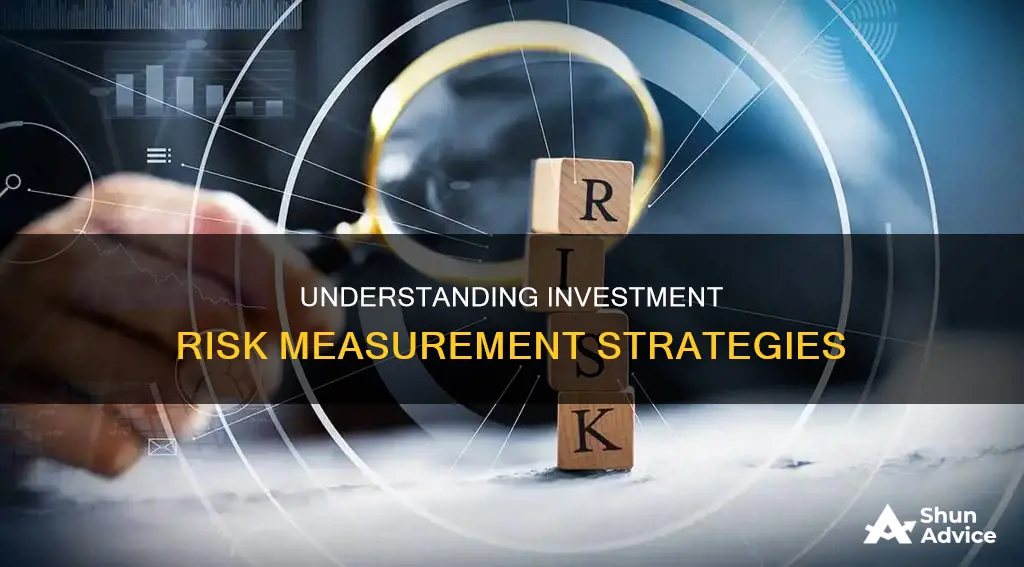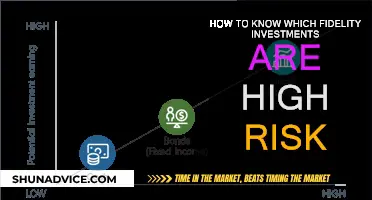
Risk is a fundamental part of investing, and understanding how to measure it is crucial for making informed investment decisions. The concept of risk in financial terms refers to the possibility of losing some or all of an original investment, with the potential for gains differing from expected outcomes. While diversification and asset allocation can improve returns, it's important to recognise that systematic and unsystematic risks are inherent in any investment venture. To navigate this complex landscape, investors employ various statistical measures and methods, including value at risk (VaR) and the capital asset pricing model (CAPM), to make informed choices. These tools help differentiate between high-risk and stable investments, with the former generally promising higher returns.
| Characteristics | Values |
|---|---|
| Volatility | How much will the price of an asset move, with a 68% probability |
| Value-at-Risk (VaR) | Measures how much a particular asset will lose in value, with a certain probability (usually 95%) |
| Alpha | Measures the performance of an investment portfolio and compares it to a benchmark index |
| Beta | Measures the volatility of a portfolio compared to a benchmark index |
| Standard Deviation | A measure of the dispersion of data from its mean |
| Sharpe Ratio | Measures the expected excess return of an investment in relation to its volatility |
| R-squared | Represents the percentage of a fund or security's movements that can be explained by changes in a benchmark index |

Volatility
There are two main types of volatility:
- Historical volatility: This is based on an asset's previous price patterns over a specific period. It is not necessarily a good predictor of future volatility.
- Implied volatility: This is used to forecast how much an investment will fluctuate in the future. It is often calculated based on options prices and generally drops in bullish markets.
Standard deviation is a common metric for measuring historical volatility, while beta is used to measure implied volatility. The higher the standard deviation, the more volatile the investment. A beta of more than 1 indicates above-average volatility.
While volatility and risk are related concepts, they are not interchangeable. High-risk investments are typically highly volatile, but high volatility does not always imply high risk, especially over the long term. For example, stocks are often volatile in the short term but are generally considered a safe long-term investment.
India's Strategic Investments in Africa: Rapid Expansion
You may want to see also

Value-at-Risk (VaR)
VaR is determined by three variables: period, confidence level, and the size of the possible loss. For example, a portfolio of stocks with a one-day 5% VaR of $1 million means there is a 5% probability that the portfolio will lose more than $1 million in value over one day.
There are three main methods for calculating VaR:
- Historical Method: This approach uses past data to predict future outcomes, assuming that historical returns will repeat themselves.
- Variance-Covariance Method: This method assumes that stock returns follow a normal distribution and only requires estimates of expected return and standard deviation.
- Monte Carlo Simulation: This technique uses computational models to simulate projected returns over numerous iterations, providing insights into potential losses.
VaR is beneficial as it provides a single, easily interpretable number that encapsulates the downside risk of an investment. However, it has limitations, such as not providing information about the severity of losses beyond the VaR threshold and potentially underestimating risk during market stress.
Mild Investment Strategies: High Risk or Safe Bet?
You may want to see also

Alpha and Beta Ratios
Alpha and beta are two statistical metrics used to quantify value and risk in investment securities. They are both risk ratios used in modern portfolio theory (MPT) to help determine the risk/reward profile of investments.
Alpha
Alpha measures the performance of an investment portfolio and compares it to a benchmark index, such as the S&P 500. The difference between the returns of a portfolio and the benchmark is referred to as alpha. A positive alpha indicates that the portfolio has outperformed the benchmark, while a negative alpha indicates underperformance. For example, an alpha of 1 means the portfolio has outperformed the benchmark by 1%.
Alpha is often considered a measure of the value created by active fund management, and it is a key reason why investors pay for quality fund managers. It is also referred to as the 'abnormal rate of return' or 'active return'.
Beta
Beta measures the volatility of a portfolio compared to a benchmark index. It captures the movements and swings in asset prices. A beta greater than one indicates higher volatility, whereas a beta under one means the security will be more stable. Beta is calculated using regression analysis and is a measure of systematic risk.
For example, a fund with a beta of 1.2 is theoretically 20% more volatile than the market. Such a fund would be expected to yield a 12% return if the benchmark's return over the same period is 10%.
Alpha and Beta Together
Alpha and beta need to be compared alongside each other to find the most appropriate balance between returns and risk management across a portfolio. While many investors favour high alpha and low beta ratios, a risk-tolerant investor might favour high-alpha, high-beta funds to capitalise on upside volatility.
An investor can manage the risks of an equity portfolio by separating it into two funds - a beta portfolio and an alpha component. The beta portion will move passively with the market, while the alpha portion will seek to generate above-average returns from risks that are uncorrelated to the market.
CFO's Investment Strategies: Where Do They Put Their Money?
You may want to see also

Standard Deviation
In finance, standard deviation is often used as a measure of the relative riskiness of an asset. A volatile stock has a high standard deviation, while the deviation of a stable blue-chip stock is usually rather low.
Big Data's Power: Smart Investing Decisions
You may want to see also

Sharpe Ratio
The Sharpe ratio is a financial metric that measures the performance of an investment relative to its risk. It was developed by William F. Sharpe in 1966 and is one of the most widely referenced risk/return measures in finance. The ratio is calculated by subtracting the risk-free rate of return from the expected rate of return, and then dividing that result by the standard deviation of the portfolio's excess return. The Sharpe ratio can be used to evaluate either an individual asset or a portfolio of assets and can be based on historical or expected returns.
The Sharpe ratio is useful for investors as it provides a quick analysis of how an investment's risk is paying off based on its returns. It describes how much excess return an investor receives for each additional unit of risk assumed. A higher ratio implies a higher investment return compared to the amount of risk of the investment. Generally, a Sharpe ratio of 1 or greater is considered good, a ratio of 2 or higher is considered very good, and a ratio of 3 or higher is considered excellent.
It is important to note that the Sharpe ratio has some limitations. It assumes that returns are normally distributed and treats upside and downside volatility equally. Additionally, it depends heavily on the benchmark used to determine the risk-free rate, which can vary across different investments. Despite these limitations, the Sharpe ratio is a valuable tool for investors to assess the risk and return of their investments.
Understanding the Private Equity Investment Cycle
You may want to see also
Frequently asked questions
Volatility is the most common measure of risk. It is defined as the likelihood of an asset's price movement with a 68% probability.
VaR is a statistical measure of the potential loss in value of a risky asset or portfolio over a given period, for a given confidence interval. It provides a single number that encapsulates the downside risk of an investment. For example, a portfolio with a one-year 10% VaR of $5 million has a 10% chance of losing $5 million over a year.
Systematic risk affects all investments and is unpredictable and undiversifiable. Examples include political risk and macroeconomic risk. Unsystematic risk is specific to a company or sector and can be mitigated through diversification. Examples include operational risk and regulatory changes.
As investment risks rise, investors expect higher returns to compensate for the additional risk. For example, a corporate bond has a higher default risk than a U.S. Treasury bond, so investors are offered a higher rate of return.
The five principal risk measures are alpha, beta, R-squared, standard deviation, and the Sharpe ratio. These measures can be used individually or together to assess the risk of potential investments.







